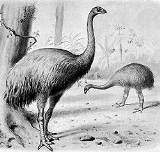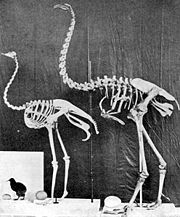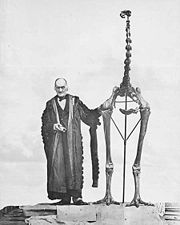
Giant moa
Encyclopedia
The giant moa is an extinct genus of ratite
birds belonging to the moa
family. Like all ratite
s it was a member of the order
Struthioniformes. The Struthioniformes are flightless birds with a sternum
without a keel. They also have a distinctive palate
. It was endemic to New Zealand
.
 Dinornis may have been the tallest bird that ever lived, with the females of the largest species standing 3.6 m (11.8 ft) tall, and one of the most massive, weighing 230–240 kg (507.1–529.1 lb) or 278 kg (612.9 lb) in various estimates. Feather
Dinornis may have been the tallest bird that ever lived, with the females of the largest species standing 3.6 m (11.8 ft) tall, and one of the most massive, weighing 230–240 kg (507.1–529.1 lb) or 278 kg (612.9 lb) in various estimates. Feather
remains are reddish brown and hair
-like, and apparently covered most of the body except the lower legs and most of the head (plus a small portion of the neck below the head). The feet were large and powerful, and the birds had a long neck that allowed them to reach tall vegetation. In relation to its body, the head was small, with a pointed, short, flat and somewhat curved beak.
The giant moa, along with other moa genera
, were wiped out by human
colonists who hunted it for food. All taxa in this genus were extinct by 1500 in New Zealand. It is reliably known that the Māori still hunted them at the beginning of the fifteenth century, driving them into pits and robbing their nests. Although some birds became extinct due to farming, for which the forests were cut and burned down and the ground was turned into arable land, the giant moa had been extinct for 300 years prior to the arrival of European settlers.
 Three species of Dinornis were long considered valid:
Three species of Dinornis were long considered valid:
They have recently turned out to be males (struthioides) and females of only two species, one each formerly occurring on New Zealand's North Island (D. novaezealandiae) and South Island (D. robustus); the North Island specimens, however, contain 3 distinct genetic lineages and may eventually be classified as new species (Baker et al., 2005).
Ratite
A ratite is any of a diverse group of large, flightless birds of Gondwanan origin, most of them now extinct. Unlike other flightless birds, the ratites have no keel on their sternum—hence the name from the Latin ratis...
birds belonging to the moa
Moa
The moa were eleven species of flightless birds endemic to New Zealand. The two largest species, Dinornis robustus and Dinornis novaezelandiae, reached about in height with neck outstretched, and weighed about ....
family. Like all ratite
Ratite
A ratite is any of a diverse group of large, flightless birds of Gondwanan origin, most of them now extinct. Unlike other flightless birds, the ratites have no keel on their sternum—hence the name from the Latin ratis...
s it was a member of the order
Order (biology)
In scientific classification used in biology, the order is# a taxonomic rank used in the classification of organisms. Other well-known ranks are life, domain, kingdom, phylum, class, family, genus, and species, with order fitting in between class and family...
Struthioniformes. The Struthioniformes are flightless birds with a sternum
Sternum
The sternum or breastbone is a long flat bony plate shaped like a capital "T" located anteriorly to the heart in the center of the thorax...
without a keel. They also have a distinctive palate
Palate
The palate is the roof of the mouth in humans and other mammals. It separates the oral cavity from the nasal cavity. A similar structure is found in crocodilians, but, in most other tetrapods, the oral and nasal cavities are not truly separate. The palate is divided into two parts, the anterior...
. It was endemic to New Zealand
New Zealand
New Zealand is an island country in the south-western Pacific Ocean comprising two main landmasses and numerous smaller islands. The country is situated some east of Australia across the Tasman Sea, and roughly south of the Pacific island nations of New Caledonia, Fiji, and Tonga...
.

Feather
Feathers are one of the epidermal growths that form the distinctive outer covering, or plumage, on birds and some non-avian theropod dinosaurs. They are considered the most complex integumentary structures found in vertebrates, and indeed a premier example of a complex evolutionary novelty. They...
remains are reddish brown and hair
Hair
Hair is a filamentous biomaterial, that grows from follicles found in the dermis. Found exclusively in mammals, hair is one of the defining characteristics of the mammalian class....
-like, and apparently covered most of the body except the lower legs and most of the head (plus a small portion of the neck below the head). The feet were large and powerful, and the birds had a long neck that allowed them to reach tall vegetation. In relation to its body, the head was small, with a pointed, short, flat and somewhat curved beak.
The giant moa, along with other moa genera
Moa
The moa were eleven species of flightless birds endemic to New Zealand. The two largest species, Dinornis robustus and Dinornis novaezelandiae, reached about in height with neck outstretched, and weighed about ....
, were wiped out by human
Human
Humans are the only living species in the Homo genus...
colonists who hunted it for food. All taxa in this genus were extinct by 1500 in New Zealand. It is reliably known that the Māori still hunted them at the beginning of the fifteenth century, driving them into pits and robbing their nests. Although some birds became extinct due to farming, for which the forests were cut and burned down and the ground was turned into arable land, the giant moa had been extinct for 300 years prior to the arrival of European settlers.
Taxonomy

- D. giganteus = D. robustus,
- D. novaezealandiae.
They have recently turned out to be males (struthioides) and females of only two species, one each formerly occurring on New Zealand's North Island (D. novaezealandiae) and South Island (D. robustus); the North Island specimens, however, contain 3 distinct genetic lineages and may eventually be classified as new species (Baker et al., 2005).
External links
- South Island Giant Moa. Dinornis robustus. by Paul Martinson. Artwork produced for the book Extinct Birds of New Zealand, by Alan Tennyson, Te Papa Press, Wellington, 2006

